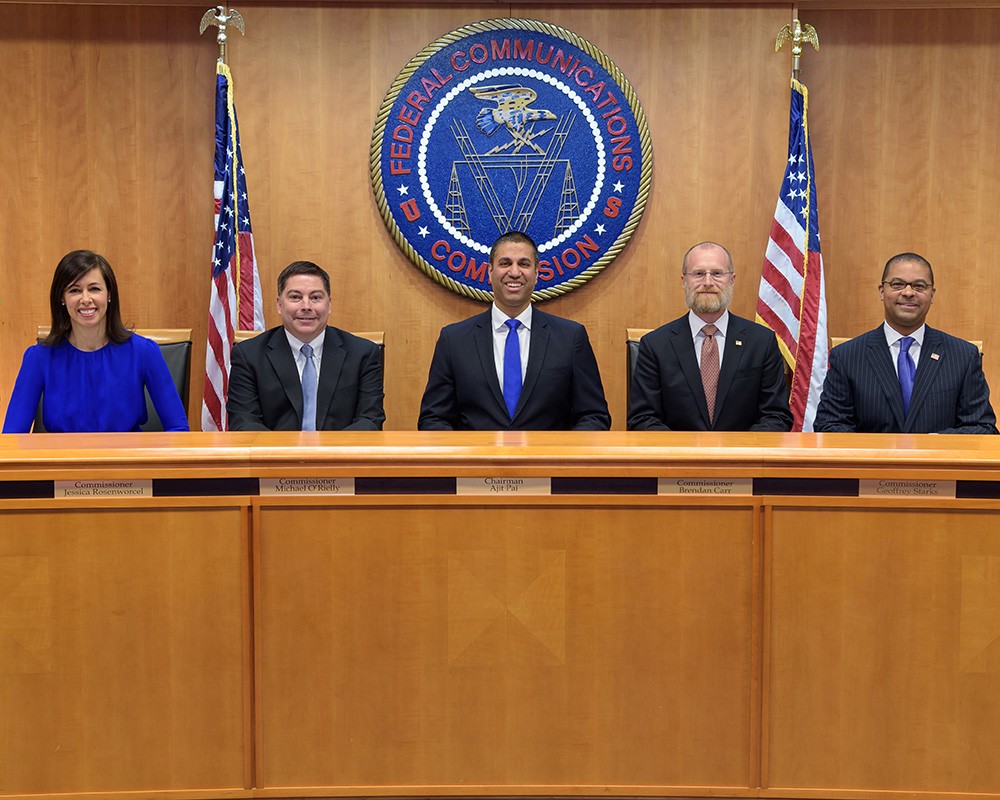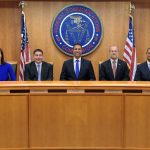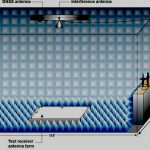The grapevine was abuzz on Halloween with chatter that the Federal Communications Commission (FCC) might soon act on a long-pending request from Ligado Networks to use spectrum near the GPS frequencies to support terrestrial communications. Testing in 2011, later confirmed by a Department of Transportation study, showed such transmissions could interfere with GPS receivers. The request has been on hold since 2012.
[Photo: Commissioner Jessica Rosenworcel, Commissioner Michael O’Rielly, Chairman Ajit Pai, Commissioner Brendan Carr and Commissioner Geoffrey Starks. Courtesy FCC.]
Citing as sources unnamed industry and former government officials, Communications Daily reported that the FCC had sent a licensing order regarding Ligado to the National Telecommunications and Information Administration for the consideration of NTIA’s Interdepartment Radio Advisory Committee (IRAC). The FCC also reportedly gave NTIA 15 days’ notice that it planned to act and, the sources said, that permission from the NTIA is not required.
The FCC does not, however, list the Ligado request on the agenda for its November 19 open meeting. Moreover there was, as of Oct 31, no mention of such a communication on a regularly updated NTIA web site that lists the status of non-federal license applications being coordinated through the IRAC.
That said, action does appear likely in the coming weeks, according to Bradford Parkinson, the chief architect of the GPS system, the first director of the GPS Joint Program Office and now the first vice chair of the National Space-Based Positioning, Navigation, and Timing (PNT) Advisory Board, the nation’s leading GPS experts. “I think it likely things will come to a head,” he told Inside GNSS.
There have been two schools of thought about how the NTIA might handle such a notification, said Tim Farrar, founder of TMF Associates. Farrar is a technology consultant specializing in the satellite industry who has closely followed Ligado’s progress. An important element in what happens next is a letter that the NTIA was supposed to send to the FCC expressing the collective opinion of the federal agencies — a letter Farrar believes was never sent.
“The original thinking at the beginning of the year was that the NTIA would send the letter and then the FCC would issue an order based on the content of that letter. However, over the summer that seemed to have shifted,” Farrar said. The NTIA said in a September spectrum update, he noted, that the FCC would take the next step.
Farrar said “it appears that there has been some decision about ‘this is the way that things will go’ in terms of the FCC drafting an order, then IRAC making a judgment on that — and perhaps there will be changes as a result of that feedback — but then the FCC will presumably issue that order once things are agreed. So, you know, the process is certainly more straightforward because you’re not waiting for some letter that might be indefinitely delayed.”
Ligado did not immediately respond to a request for comment
If a licensing order has been sent, the IRAC is required to respond, said Farrar. The results and the timing of such an exchange, however, remain unclear. “What we don’t know is what IRAC will say. We don’t know what conditions might be placed on that order in terms of restrictions on Ligado. And we don’t know exactly, although IRAC should come to a position within about 15 days, we don’t know exactly how quickly the FCC would act to issue an order.”
The IRAC can send the order back to the FCC, he said, and say, ‘we’re not going to agree to this until you clarify certain things.’ There could also be conditions. Ligado has promised to fix any government GPS devices that are impacted by its activities. The company has also suggested, said Farrar, that the requirement to be simply for it to set up a process for fixing government devices rather than to actually fix them before initiating operation. “That’s one of the areas that is going to require a close examination of the degree to which (it) might restrict Ligado’s ability to operate.”
The government also relies on equipment and services operated by the private sector. Impacts on the private sector do not appear to be covered by any agreement so far.
“There is overwhelming evidence that allowing Ligado to operate as proposed will degrade GPS and other satnav services for important user groups,” said Dana Goward, the president and director of the Resilient Navigation and Timing Foundation. “These include high precision users, such as survey, construction, and scientific applications, and some aviation uses.”
“Aviation is a particular concern,” Goward said. “In June NASA reported that a passenger aircraft nearly struck a mountain because of GPS interference while it was trying to land. This and numerous other incidents resulted in the UN’s International Civil Aviation Organization formally identifying “an urgent need” to address such interference. ”
“The sad part is this is a process that should have been resolved with the extensive testing done by the Department of Transportation,” said Parkinson. “It clearly showed that there were severe risks and degradations from any kind of increase or re-purposing of that particular spectrum. The point is the scientific and technical evidence and the weight of those who are users, has all said the same thing. Why this is dangling, I have no idea.”
“GPS has become such an important utility for so many technologies,” said Goward, “that officials at the department of Homeland Security have called it a single point of failure for critical infrastructure. Doing anything to compromise it would be against the national interest. Most users have no alternative to GPS and other satellite navigation and timing.”






